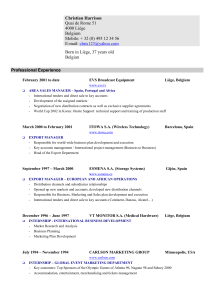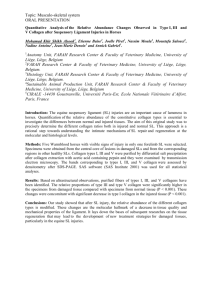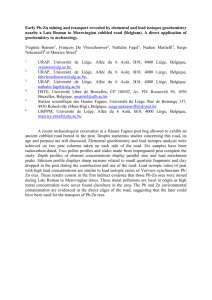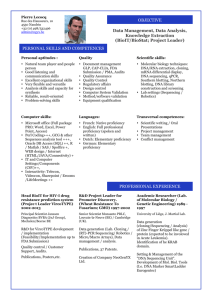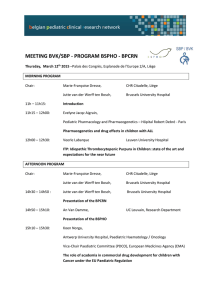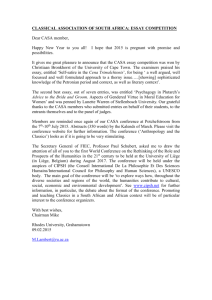CONNAISSEZ-VOUS LE CŒUR HISTORIQUE DE LIEGE
advertisement
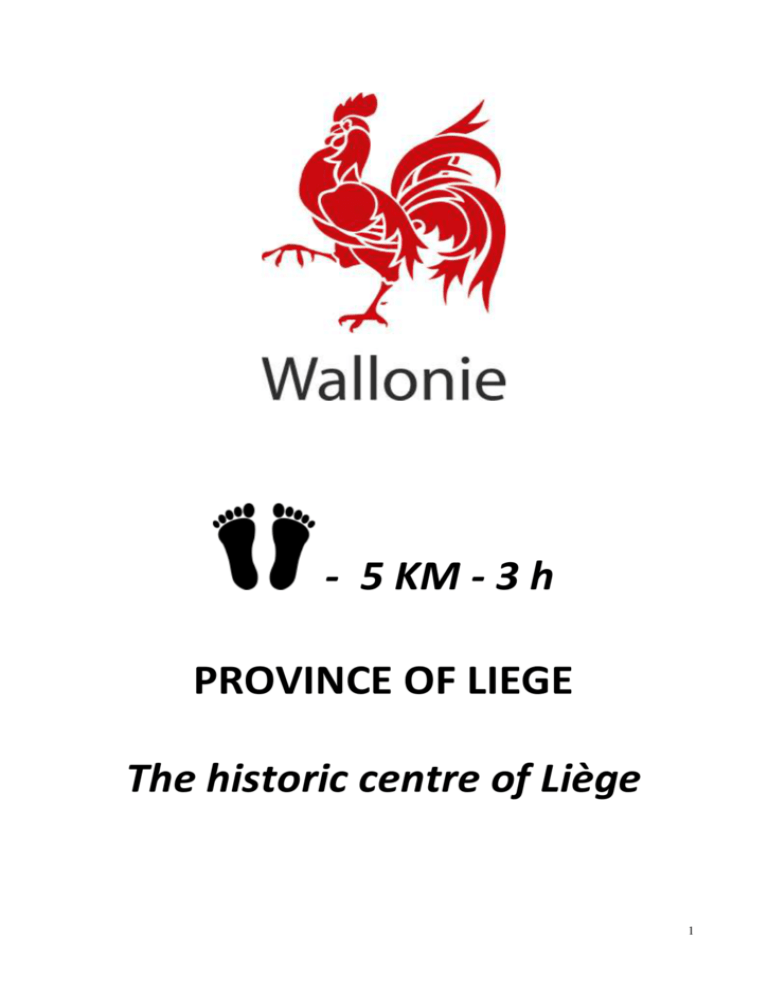
- 5 KM - 3 h
PROVINCE OF LIEGE
The historic centre of Liège
1
On the move all summer!
In BRUSSELS, from 25 June to 3 September, the “Tourism and Gastronomy" exhibition will offer you a
chance to discover the many assets and treasures of Wallonia. Every two weeks, one Province will be given
pride of place. However, we know there’s nothing like getting out and about if you’re looking for an indepth experience, so why not try one of our “Gastronomic Treasure Trails"?
All the treasure trails are free and available from 25 June to 16 September 2012, (except for the Charleroi
Pays de Geminiacum Treasure Trail). Simply turn up on one of the dates mentioned below and enjoy a
delicious free welcome treat to send you on your way!
Province of Walloon Brabant
NIVELLES
Province of Liège
LIEGE
EUPEN
Province of Namur
NAMUR
Province of Hainaut
CHARLEROI
MONS
TOURNAI
Province of Belgian Luxembourg
ARLON
Along the streets
Rural excursion
Rural excursion in the “Roman Païs”
On foot
By bicycle
By car
The historic centre of Liège
An encounter with Tchantchès and
Simenon
The Eastern Cantons: nature, lakes and
regional specialities
On foot
On foot
Namur for the inquisitive and for
gourmets
Castles, vineyards and farms around
Namur
On foot
The Charleroi region, as you have never
seen it before!
Regional products and heritage in the
“Entre-Sambre-et-Meuse”
Pays de Geminiacum treasure trail
On foot
Heritage, Tourism and Gastronomy at
the heart of Mons
By car
Free breakfasts on Sundays 1 and
8 July
Free breakfasts on Saturdays 14
and 21 July
Free breakfasts on Sundays 15
and 22 July
Free breakfasts on Wednesdays 1
and 8 August
By car
By bicycle
or car
By car or
bicycle
On foot
From the “Château Montois” to
“Caillou-qui-bique”
From “Caillou-qui-bique” to the
“Château Montois”
The historic heart of Tournai
Landscapes of the Escaut plain
By car
On foot
By car
A small breath of Arlon air
A large breath of Arlon air
On foot
On foot
By car
Free breakfasts on Saturdays 11
and 18 August
Treasure trail available only on
Wednesdays 15 and 22 August
Free breakfasts on Saturday 11
August – Free afternoon snacks
on Saturday 18 August
Free breakfasts on Saturday 11
August
Free afternoon snacks on
Saturday 18 August
Free breakfasts on Saturdays 11
and 18 August
Free breakfasts on Saturday 25
August and Sunday 2 September
INFORMATION: www.wallonie.be – Freephone: 0800 11901 (in French)
or 0800 11902 (in German)
IN PARTNERSHIP WITH SNCB BELGIAN RAILWAYS, TRAVEL SMART!
Travel to the starting points of our treasure trails with a “Weekend” ticket, which offers you a 50% discount
on the price of a return journey by train.
If you are doing one of the treasure trails on a weekday in July and August, opt for the “Summer” ticket
which also offers you discount on the price of a return journey by train.
For more information, visit www.be-rail.be
2
THE SUMMER GASTRONOMY TREASURE TRAILS
Discovering Wallonia, from Tournai to Eupen, from Nivelles to Arlon...
Does the summer sunshine make you want to get out and about?
Starting at the Espaces Wallonie, roads, streets, paths and tracks will lead you over hills and down valleys to
discover the treasures of Wallonia. Heritage, gastronomy, landscapes and outstanding historic sites - there
is something for everyone.
To ensure all participants, especially the gourmets, get off to the best of starts with a full stomach, free
breakfasts or afternoon snacks will be available on certain days.
And, before starting your trails, why not find out more about the wealth of services offered by the Espaces
Wallonie: from information about housing to debt conselling, from Equal Opportunities to the regional,
federal and community mediation services, plus a range of regional publications and exhibitions. In short, a
modern administration, close to your needs and ready to answer all your questions.
But, enough said, now it’s time to get on your bicycle, pull on your walking boots, or climb inro your car and
take to the road...
COMPETITIONS THROUGHOUT THE SUMMER...
for those who enjoy a challenge...
The guide to each treasure trail includes a set of questions. Write your answers in the spaces provided,
drop it off at the Espace Wallonie reception or letterbox when you have finished and you could win a prize!
Prizes
Every month:
A gourmet basket worth €60 will be awarded to the first correctly completed answer form pulled out
of the hat at the end of July, end of August and end of Septembe in each participating Espace Wallonie.
(Except for the Pays de Geminiacum treasure trail, where the prize draws will be held on 15 and 22 August only for a gourmet
basket worth €50).
On the days when free breakfasts or afternoon snacks are offered (see table)
A voucher worth €150 for accommodation in Wallonia.
The prize draws will take place on the first working day following these days.
Two free return tickets for second-class travel on Belgian railways
offered by SNCB Belgian Railways. The prize draws will take place on the first working day following these
days.
Prize winners will be informed by email, telephone or post.
Will you be the “Gourmet treasure trail (wo)man” of the
summer?
There will be another prize draw for a special prize for participants who submit
completed questionnaires for at least one treasure trail per province between 25
June and 16 September. To enter this draw, please ask for your entries to be
validated at each Espace Wallonie.
The prize is a voucher worth €500 for accommodation in Wallonia and the draw
will be held at the end of September.
3
PROVINCE OF LIEGE
The historic centre of Liège
Bonus!
Free breakfast on Saturdays 14 and 21 July 2012, from 9am to 10.30am at the
ESPACE WALLONIE DE LIEGE, 86, Place Saint-Michel, 4000 LIEGE
On these days, final departure at 4 pm. Completed questionnaires must be placed
in the box at the Espace Wallonie before 6pm.
This treasure trail is free of charge and is open to all from 25 June to 16 September
Treasure trail on foot
Duration: about 3 hours
Length: about 5 km
Accessible by accompanied reduced-mobility participants
Liège is known as the “glowing city” because there is always something going on
there. On 17 September 705 AD, what was then the village of Liège became
famous when Bishop Lambert was martyred here. A church was built in his
memory and then, after he was canonised, a cathedral. Liège grew into a powerful
city-state ruled by a Prince-Bishop who was an Elector of the Holy Roman Empire
and whose influence extended across Europe. Nowadays, the historic centre of
Liège has many tourist attractions: St Martin’s tower, the Archéoforum
archaeological museum which includes the underground vaults of the former St
Lambert’s Cathedral, some magnificent mediaeval fonts in churches, the Law
Courts building (the former palace of the Prince-Bishops), the old market square,
the enormous flight of steps up to the citadel (known as Buren’s mountain), the
bustling La Batte market and the Town Hall. Multilingial guides offer tours. In
Liège, a warm welcome is more than just words, it is a long-standing, proud
tradition. Come and discover the city’s history and, above all, its pleasant lifestyle
by tasting and sampling its gastronomic specialities and enjoying Liège-style
hospitality as you follow in the footsteps of one of its most famous inhabitants,
Georges Simenon, the author who created the detective Inspector Maigret.
INFORMATION and CONTACTS
From Monday to Friday from 8.30am to 5pm: ESPACE WALLONIE DE LIEGE, 86, Place SaintMichel, 4000 LIEGE – Tel: +32 (0)4 250 9330
E-mail: ew.liege@spw.wallonie.be
At weekends: MAISON DU TOURISME, 32-35, Place Saint-Lambert, 4000 LIEGE Tel: +32 (0)4
237 9292 – E-mail: mtpaysdeliege@provincedeliege.be
MISCELLANEOUS:
If you would like to follow the treasure trail in a group of more than 10 people, please inform us in
advance by e-mail or telephone.
4
The historic centre of Liège
This treasure trail invites you to discover the history of the oldest neighbourhood in Liège which
includes the cathedral, the Carré district, the Place Saint-Lambert, the old market square, the Rue
Hors-Château and the Rue Féronstrée.
The Espace Wallonie in Liège is housed in the former home of the Desoër de Solières family, a
building attributed to Lambert Lombard (1505-1566), a Liège-born artist and architect.
Question 1:
A. In which architectural style is the building?
B. Who commissioned it?
To the right of the Espace Wallonie stands the Bocholz house, a beautiful Meuse-valley-style
house, built initially for a canon from the chapter of St Lambert’s cathedral in the sixteenth
century.
Question 2: What was the canon responsible for?
Walk along the Rue Haute Sauvenière. On the right, you will see stones in the buildings taken from
the old city walls and the outbuildings of the Holy Cross church.
On the left, you will see the restaurant “Chez Philippe” (1), reputed to serve the best
boulets (meatballs) in Liège, along with other local specialities. Further along the street on the
right is the Holy Cross Collegiate Church, which is undergoing a major restoration. The three naves
are unusual because they are all equal in height, reminiscent of a German “hall church”. Make
your way to
s and enter the small courtyard with attractive seventeenth-century
facades and the tiny Church of St-Nicolas-aux-Mouches.
Then turn into the Rue Saint-Pierre. At No.13, a plaque commemorates the birthplace of the
famous composer and organist, César Franck, who was born in Liège when it was part of the
United Netherlands, and who died here when it was part of France.
From the walkway, you can admire the western side of the Provincial Government’s headquarters,
decorated with sculptures and low-relief panels.
Next, make your way to the Ilôt Saint-Michel and walk down the Rue de l’Official. Here you will
find a sign which reads “L’âme du folklore Wallon, enfant de la place Saint-Michel” (“The soul of
Walloon folklore is a child of the Place St Michel”).
Question 3: Who is depicted on this sign?
Go down the flight of steps to the Rue de la Populaire and cross it to the Royal Theatre, built in
1822. It was built cheaply by re-using stone and bricks from the three churches destroyed in Liège
during the French revolutionary era. In front of the Theatre is a statue of André-Ernest-Modeste
Grétry, a famous violinist and composer from Liège (1741-1813), whose heart is contained in an
urn inside the pedestal of the statue.
5
Question 4: What was the occupation of André-Ernest-Modeste Grétry’s father?
Go down the left-hand side of the Royal Theatre along the Rue Georges Clémenceau, named after
the Prime Minister of France during the First World War, who united his people and led them to
victory in 1918. The City of Liège named this street after him shortly afterwards.
At No.19, you will find “Lemlyn” (2), a delicatessen which offers a selection of local
specialities.
Question 5: Solve the riddle displayed in the shop window
Turn left onto the Rue des Dominicains and then right onto the Rue du Pot-d’Or, which was given
its name in the sixteenth century (“Golden Pot Street”) because of one of the street signs there.
At No.2 you will find the “Galler” chocolate shop (3), where you can taste some delicious
artisanal chocolates.
You are now in the centre of the quadrangle formed by Rue Pont d’Avroy and Rue de la Casquette,
known as the Carré. It is a maze of shops and meeting places, which are all lit up at night: exotic
restaurants, luxury restaurants, bistros and nightclubs. The old island has become a haven of
pleasure.
Take the Rue du Mouton Blanc on the left, which is named after Gilles Mouton, who worked as a
tawer. He attached a sign to his home, which can now be found at the Museum of Walloon Life.
Question 6: What does a tawer do?
At No.22 you will find Jean-Philippe DARCIS’s artisan chocolate shop (4).
Make your way to the Place Cathédrale and the Vinâve d'Ile: a vinâve was an island
neighbourhood, surrounded by water. Above the fountain stands a bronze statue called "The
Virgin and Child" by Jean Del Cour (1695).
In the left-hand corner of the square, you will find the Galerie Cathédrale, where there is
another chocolate shop ”Chocolat Artisanal Mosan” (5).
Return to the Place Cathédrale.
After the Concordat of 1802, St Paul’s church became the Cathedral of Liège, replacing St
Lambert’s Cathedral which had been destroyed in 1793 by revolutionaries. St Paul’s was chosen in
preference to St James’s and St Martin’s churches because of its more central location.
St Paul’s was originally founded as a collegiate church by Bishop Eracle, Prince-Bishop Notger’s
predecessor.
6
The original Romanesque church was built between 966 and 1240, and was later demolished and
replaced by the church we see today, which was built in several phases and completed in the early
fifteenth century. The tower was started in 1390 and remained incomplete for many years: it was
only finished in 1810, using stone from the ruins of St Lambert’s Cathedral. The silhouette of the
spire, surrounded by four small steeples, is an intentional reference to the main tower of St
Lambert’s Cathedral, from which it inherited its clock and carillon.
Go into the Cathedral and admire the sixteenth-century stained-glass windows, the Baroque
recumbent effigy of Christ in white marble by Del Cour and the outstanding nineteenth-century
furniture. The Cathedral has one of the most beautiful Gothic cloisters in the Belgium. You can visit
the Treasury from the cloisters.
Take the exit from the cloisters to the Rue Bonne Fortune, then turn right onto the Rue Saint-Paul.
On the corner is the old-fashioned Taverne Saint-Paul which welcomes visitors. This road is more
than eight hundred years old and today contains many bars and shops. Turn left onto the Rue des
Carmes, where a Carmelite convent used to stand.
At N°3, you will find “Philosophie de Cuisine” (6), a culinary workshop whose chef prepares
regional specialities using organic ingredients.
Turn left on to Place du XX Août, whose name recalls the terrible day of 20 August 1914, when
German troops burned down several houses and massacred 28 people. On your right are buildings
belonging to the University of Liège, founded in 1817.
Question 7: Who founded the University of Liège?
In 1881, the University admitted its first female student, to study for a degree in pharmacy.
Question 8: What was the name of the University’s first female student?
Go past the University to the Place Cockerill, where, at N°18, you will find “Saveur Bio du
terroir Al Binete”, an organic grocer’s shop (7)
Turn left onto the Rue de la Régence, then left again onto the Rue Cathédrale, then right onto the
Rue Lulay-des Fèbvres. This used to be a district inhabited by the city’s blacksmiths, locksmiths and
other iron workers, accessed via the Pont d’Ile bridge.
At N°11, you will find “Le Lulay – Al Copète” (8) where Mr and Mrs Lardinois sell a range of
local specialities.
Question 9: The Liège white pork sausage is flavoured with which herb?
7
Go down the Passage Lemonnier on the right. This was the first shopping arcade in Belgium (it
opened in 1839) and was named after its architect.
Question 10: How many metres long is the Passage Lemonnier?
Cross the Rue de l’Université and the Rue de la Régence, then turn right onto the Rue de la Wache,
which takes its name from the field of barley ('wache’ in Walloon ) that used to be here.
Go to the entrance of St Denis’s church on the Rue Cathédrale. The doorway is marked with the
levels reached by the waters of the River Meuse during various floods.
Question 11: In what years did these floods occur?
Until the twentieth century, the waters of branches of the River Meuse flowed where the
Boulevard Sauvenière, the square, the Rue de l’Université and the Rue de la Régence are today.
Question 12: Mark the streets on the plan
Go into the church, walk through it and leave through the door to the eighteenth-century
cloisters, which house several statues that are venerated by locals, who light candles in front of
them.
St Denis’s church is one of the oldest buildings in Liège : it was founded at the end of the tenth
century by Prince-Bishop Notger. The building we see today provides a comprehensive lesson in
historical architectural styles: the nave is Romanesque, as is the large narthex tower (as the tower
has no external door, it was a perfect defensive refuge). For ten years, the composer Grétry sang
in the choir here. Some works of art in the church deserve your attention: several sixteenthcentury paintings by Lambert Lombard in the side aisles (16th century), and the wonderful, early
sixteenth-century, Gothic wooden reredos in the right-hand transept, which depicts the Passion of
Christ in six panels, above five panels recounting scenes from the life of St Denis.
In the thirteenth century, the small wooded square outside the church was home to the city’s
potters.
Question 13: Riddle:
I am round or square and well-moulded. When served at the market, I am cut up.
It is not worth making just one of me, especially for not much of anything.
What am I?
Opposite the church, the large Gothic-Renaissance style building, dating from the late-sixteenth
and early-seventeenth centuries used to house the Imperial Post Office.
Make your way to the Rue St Etienne and the newly named Place St Etienne, then go down the
Galeries St Lambert to the Place St Lambert, the heart of Liège.
8
For many years, controversy raged about what to do with this square, following the destruction of
St Lambert’s Cathedral. Today, the square has been levelled with a three-dimensional framework
marking the layout and structure of the Cathedral. During the restoration work, archeaological
remains from the Middle Palaeolithic period (about 50,000 BC) were found here, beneath the
remains of a large Roman villa, which in turn were beneath the remains of a Merovingian town,
which in turn were beneath the foundations of the first Cathedral, built by Notger, the first PrinceBishop. Today, artefacts from all these remains can be admired in the Archéoforum.
Question 14: In 1907, who was the first archaeologist to discover the underground
treasures of the Place St Lambert?
Having undergone extensive rebuilding, the centre of Liège now meets the needs of its presentday inhabitants and visitors. However, care has been taken to remind them of the religious origins
of this ancient episcopal principality. For many years, parents used to bring their children here to
have their photos taken in an aeroplane that used to stand on the square, in front of the Palace of
the Prince-Bishops. The plane was eventually removed, but thirty years later it was reinstalled
here after a local fund-raising campaign. Today the plane contains statues of two caricature Liège
people: grumpy, rebellious, loud-mouthed, hating pomp and ceremony, fiercely independent but
with hearts of gold and quick to defend good causes.
Question 15: What are the most impertinent resident of Liège and his partner
called?
These streets used to resound with the cries of street-traders and pedlars, who laid out their
wares outside the Grand Bazar department store, on the Place du Marché and in other parts of
the city, where they accompanied everyday life for the city’s residents and set the pace of life for
the “glowing city”.
Question 16: What do these old Liège-dialect street cries mean in modern French
or English?
a) Cutès peures madame!
b) Traze bellès d'jeyes pou cing censes!
Now walk down the Rue Léopold to N°24 where a commemorative plaque marks the birthplace of
Georges Simenon. Cross the road and go down the Rue de l'Hôtel de Ville until you come to a
square, which was called the Place Léopold until recently.
Question 17: What is the square’s new name?
The Town Hall deserves your full attention. The locals call it “La Violette”, (“The Violet”) which was
the building’s name before it was taken over as a meeting place by first independent city council in
the thirteenth century. The original building was demolished by Duke Charles the Bold of
Burgundy’s trrops in 1468, then by soldiers of King Louis XIV of France’s army in 1691.
The building we see today was built between 1714 and 1718 in the Classical style.
9
Question 18: On the coat-of-arms of the City of Liège is the perron (column with
steps) and the letters L and G. What do these letters stand for?
Go behind the Town Hall, and turn right onto the Rue du Stalon.
At N°1 is the “Amon Nanesse” restaurant (9), which serves traditional Belgian food in an
old-fashioned setting.
Go past the pékèt shop and follow the Rue de l'Epée until you reach the Rue Neuvice, a vinâve
dating back to the twelfth century which connected the bank of the River Meuse to the market
square, and which used to be a busy shopping street. Like almost all of the neighbourhood, it was
destroyed in the bombardment of Liège by the French army in 1691, so most of the facades you
can see today date back to the eighteenth century. Many are decorated with old-fashioned metal
signs.
Turn down the fourteenth-century Rue du Carré, famous for being the narrowest street in Liège,
then cross the Rue du Pont and continue along the Rue de la Boucherie. Note the group of
eighteenth- century overhanging timber-frame houses on the left. Timber was a popular building
material because it was cheaper than brick or stone. On the other side of the street, at N°7, a
plaque commemorates the birthplace of a painter.
Question 19: What is this painter’s name?
Opposite, on the corner, you will see the Halle du Nord, also called the Halle aux Viandes. This
eighteenth-century limestone building is the oldest secular building in the city. It was restored
with funding from the Walloon Region, the European Heritage Fund and Liège City Council. Until
recently, it was home to the guild of the “Mangons” (Butchers).
Question 20: Translate into modern French or English the names of these other
guilds in Liège:
a) Les charliers
b) Les sclaideurs
c) Les naiveurs
d) Les texheurs
e) Les Soyeurs
As in many other European cities, the thirteenth and foruteenth centuries in Liège were marked by
social unrest. The Peace of Fexhe, signed in 1316, gave the city’s guilds a voice in the government
of the city.
On the night of 3 August 1312, a dispute between the rich merchants and their poorer neighbours
erupted into violence. The merchants sought refuge in St Martin’s church, where they were
surrounded by an angry mob, who set fire to the church and burned them to death. In 2012, we
will commemorate the 700th anniversary of this event.
10
Question 21: What is the name of this event?
Turn right along the Rue de la Goffe, whose right-hand side is lined with seventeenth and
eighteenth-century facades. At N°12 a plaque marks the birthplace of the Liège revolutionary
Bassenge, which, a century later, became the home of the Walloon poet, Nicolas Defrêcheux, who
wrote the famous song "Lèyîz-m'plorer" (“Let me weep”).
The Quai de la Goffe was part of the port of Liège, where goods were loaded onto, and unloaded
from, the ships which travelled along the River Meuse, which was a vital trade route for the city.
Today, every Sunday morning, this long quayside is transformed into the huge La Batte open-air
market.
Continue along the quay and turn down the Rue Potiérue, then turn right onto the Rue Féronstrée,
a very old street which was once the main road to Maastricht. Turn right onto the pedestrianised
Rue St-Georges.
The staff at the Tourist Information Centre at 92 Rue Féronstrée may be able to help you answer
the more difficult questions on this questionnaire! Go past the Museum of Walloon Art, where you
can see the collection of paintings and sculptures by local artists which belongs to the Walloon
Regional Government.
Then do a u-turn and turn right onto the Rue Hongrée, then left onto the narrow Rue sur les
Foulons. This street was home to the city’s fullers (cloth-finishers) in the thirteenth and fourteenth
centuries. They used clay and urine to remove the grease from woollen cloth. At the entrance to
the street on the right is a fountain named after the donors who donated it to the city at the end
of the nineteenth century. It originally had metal cups chained to it for passers-by to use to
quench their thirst. The lower basins were for horses and dogs.
Turn right onto the Rue Saint-Georges and then turn left along La Batte towards the Quai de
Maastricht. At the corner of the Rue Hongrée, at N°2, the inscription on the facade of the
eighteenth-century Hôtel de Posson brings to mind the bells of stagecoach horses, a far cry from
the thunder of traffic and the exhaust fumes of today’s dual carriageway nearby. But we shouldn’t
feel too nostalgic: the stagecoaches that would have left here in the eighteenth century travelling
to Switzerland and Italy were neither very comfortable nor very fast.
At N° 30, you will find the reasonably priced restaurant “L’œuf au plat” (10).
Retrace your footsteps to the Quai de Maastricht and the imposing brick facade with limestone
pilaster of N°8, a building dating back to 1775 which used to house the Armoury Museum. A
plaque informs us that the building was the Prefecture of the French département de l’Ourthe
when Liège was part of Revolutionary France, and then the Governor’s residence under the First
Empire, when Emperor Napoleon I visited, first with Empress Josephine, then with Empress MarieLouise.
11
Since 1909, this building has been home to the Grand Curtius museum, which covers a surface
area of 10,000 m². Its displays include weapons, glass, archaeological finds, decorative arts,
religious art and Mosan (Meuse-valley) art.
Cross the museum’s courtyard to reach the Place St-Barthélemy. From the fountain in the squre,
there is a beautiful view over the renovated St Bartholomew’s collegiate church, which was
founded outside the city walls, and is characteristic of the imposing late-eleventh-century
Ottonian style. In the eighteenth century, two aisles were added by opening the Western neoclassical portal, and the interior was redecorated in the French Baroque style. Inside the church is
one of the seven wonders of Belgium: the eleventh-century baptismal font.
Walk around the square and turn left along the Rue des Brasseurs (Brewers’ Street), which
commemorates the fact that beer has been brewed in Liège since at least the twelfth century.
Then turn right into the Cour St-Antoine, a beautiful example of successful urban renewal, funded
by the Walloon Reginal Government. This site had been abandoned by its inhabitants and had
fallen into deriliction by the 1970s, when a project to attract people back to the city centre to live
was launched. The result is a clever combination of traditional and modern architectural styles, a
peaceful village square. Nothing is missing: fountain, benches and a statue, the Guatemalaninspired sculpture “Tikal”.
Leave the courtyard by the other exit, and turn left onto the Rue Hors-Château, whose name is
derived from its original location in the eleventh century outside the city walls. Its many attractive
houses, with their unusual impasses (blind alleys) add to its charm. At N°45, turn right into the
Impasse de l'Ange. These seventeenth and eighteenth-century houses were originally inhabited by
labourers and tradesmen, and were laid out along six blind alleys facing the hillsides where there
used to be vineyards, which were a French monopoly and were destroyed in the reign of King
Louis XIV. The houses have been gradually restored by their owners, often in very different styles,
but always in the same attractive, human-scale spirit.
Note the niche with the Virgin and Child at the junction between two of the blind alleys: there are
many more in the Outremeuse district and they are decorated with flowers for the festivities
surrounding Assumption Day on 15 August each year.
Go down the parallel blind alley and return to the Rue Hors-Château, then turn right. Slightly set
back from the road on the right is the bottom of “Buren’s Mountain” a flight of 374 steps leading
up to the citadel (70m above). It was built in 1880 as a direct route to the city centre for the
soldiers stationed at the citadel fortress. The view from the top is magnificent.
On the other corner, a pale-coloured building which looks slightly like a temple, bears an enigmatic
inscription: "Culte Antoiniste". It is one of the first Antoinist temples, founded in the early
nineteenth century.
Opposite, stands the “Pisseroul” fountain, originally erected in the fourteenth century and
surmounted in the seventeenth century by a bronze statue of St John the Baptist by Del Cour. It
provided water for the neighbourhood for many years. The water to feed the fountain travels
along an araine (a gallery hollowed out of the hillside to drain a coalmine). In the late sixteenth
century, some of the richer local households connected pipes to it to obtain running water.
12
Make your way to the car park. On your right, you will see the Museum of Religious Art and, to the
rear of the car park on the Cours des Mineurs, the Museum of Walloon Life, the most beautiful
and richest museum devoted to the ethnography and folklore of Wallonia. It is situated in a former
Franciscan monastery which has been beautifully restored. The 35,000 documents and objects
preserved there depict the tangible, family, social, political, religious and artistic life of Walloons
from the past to the present day.
At the Museum Cafeteria (11), you can have a rest and something to eat and drink. The
museum organises a programme of puppet shows for children starring Tchantchès.
Although the tradition of marionette shows in Liège is not very old (they were introduced by an
Italian in the mid-ninteenth century), they have become an integral part of Liège popular culture.
Question 22: Tchantchès is a fighter (defending the widow and orphan), and he
has a secret boot. Which one?
Make your way to the Place du Marché, which is no doubt as old as the city itself. Over the years,
it has served as a meeting place for the city's inhabitants. It was damaged by the French
bombardment in 1691 and its present-day appearance dates from the eighteenth century.
Question 23: Who bombarded Liège in 1691?
At the centre of the square, the large fountain is surmounted by the emblem of Liège, the Perron,
which is both a monument and a symbol. The column surrounded by steps originally served as the
city’s stocks, where criminals were pelted with rotten fruit and vegetables by passer-by. Strangely,
the Perron gradually became the symbol of the people’s rights and freedoms, even appearing on
the city’s coat-of-arms.
It was such a strong symbol and rallying-point that Duke Charles the Bold of Burgundy, wishing to
show his complete control over the principality, “exiled” the Perron to Bruges in 1467.
You can enjoy traditional Liège specialities at the restaurants lining the square: “La Table
d'Upignac” (12), “Le Vin sur Vin” (13) and “La Maison Massin” (14).
Question 24: The Perron and the Town Hall are decorated with pine cones.
Why?
Opposite you is the former Palace of the Prince-Bishops, now home to the Law Courts and the
Provincial Government. The complex of buildings bears witness to different periods and styles of
architecture, mainly Gothic and Renaissance. The first courtyard, with its Italian-style loggias,
contains sixty columns, all decorated differently. The second, more private courtyard (not open to
the public) is reminiscent of a rural cloisters and was the Prince-Bishop’s private retreat.
13
The first Prince-Bishop, Notger came to power in 980, during the reign of Holy Roman Emperor
Otto II, and set about making Liège one of the most important city-states in the Holy Roman
Empire. Notger fortified the city by building a wall around it and encouraged people to settle on
the island by dredging the River Meuse. He started building the Romenesque cathedral dedicated
to Our Lady and St Lambert on the site of St Lambert’s martyrdom, as well as seven collegiate
churches and two Benedictine abbeys.
Question 25: Whose castle was demolished by Notger?
The Principality of Liège was a multilingual state which included 23 towns: 11 in Wallonia and 12 in
Flanders. Thus, the proclamation of the election of a new Prince-Bishop was made in Latin, French
and Flemish. The government was conducted in both French and Flemish, a benefit never enjoyed
by the citizens of Maastricht and Bouillon.
Return to the Espace Wallonie at 86, Place St Michel and leave your completed
questionnaire at the Reception or in the building’s letterbox (No. 86).
Thank you for taking part and see you again soon!
We kindly acknowledge the assistance of the following books:
“Guide de Liège et Pays de Liège” by Christian Libens.
“Les Rues de Liège”
“Noir Dessin Production”
“Le Petit Futé”.
14
WHERE TO ENJOY
SPECIALITIES FROM THE REGION OF LIEGE
1) “Chez Philippe”
39, Rue Haute Sauvenière, 4000 Liège, Tel +32 (0)4 237 0454
Closed on Saturdays and Sundays – Open Monday to Friday from 11.30am to 2pm and from 6pm to
midnight.
In 2011, Philippe Goormans won the Boulet de Cristal (“Crystal Meatball”) award for his meatballs.
Other dishes include: Liège Crayfish – Goat’s Cheese Salad with Apples and Syrup – Calf’s Head Brawn –
Steak Tartare – Café liégeois (coffee ice-cream) – Tchantchés Sabayon.
2) “Lemlyn” (delicatessen)
19, Rue Georges Clémenceau, 4000 Liège. Tel +32 (0)4 223 1678
Shop selling regional specialities. Closed on public holidays
Examples: Upignac Foie Gras – Charlier Sirop de Liège – Delvaux Sirop de Liège – Roisin Wines –
Galler Chocolates – Aubel Biscuits – Café Liégeois – Walloon Cheeses (Herve, Chimay, Orval, etc)
3) “Galler” Chocolatier
Artisanal chocolates
39, Rue de la Station, 4051 Vaux-sous-Chèvremont. Tel +32 (0)4 365 9220
Chocolate bars, boxes of chocolates, chocolate biscuits, chocolate spreads, filled chocolate bars (22
flavours), chocolate cakes.
www.galler.com
4) “Jean-Philippe Darcis” (artisan chocolatier-patissier)
22, Rue du Mouton Blanc, 4000 Liège
Fine cakes, chocolates, macaroons, jams and ice-creams.
5) “Chocolat Artisanal Mosan”
40, Galerie de la Cathédrale, 4000 Liège. Tel +32 (0)4 222 0343
Boxes of chocolates – Truffles – Chocolate bars – Homemade ice-cream (in season)
Cuberdon sweets and candied fruit – Macaroons – Chocolate cakes
6) “Philosophie de Cuisine”
3, Rue des Carmes, 4000 Liège. Mobile Tel +32 (0)496 706 454 or +32 (0)499 252 818
Isabelle and Philippe Renard’s organic culinary workshop
Regional specialities served from Tuesdays to Saturdays, from midday to 2.30pm
Closed on Sundays and Mondays.
www.philosophiedecuisine.be
7) “Al Binete – Bio saveur” (organic grocer)
18, Place Cockerill, 4000 Liège. Tel +32 (0)4 221 2164
Open from Tuesdays to Saturdays, 9.30am to 6.30pm – Sundays from 9.30am to 1.30pm
Organic fresh regional produce.
15
8) “Le Lulay – Al copète”
11, Rue Lulay des Febvres, 4000 Liège. Tel +32 (0)4 222 0670
Closed on Sundays, Mondays and Thursday evenings
www.lelulayalcopete.be
Examples: Calf’s head brawn– Fillet steak – Breast of Chicken with lardons – Skirt steak with shallots - Café
Liégeois coffee ice-cream - Apple pancakes – Regional cheeseboard
9) “Amon Nanesse”
1, Rue du Stalon, 4000 Liège. Tel +32 (0)4 250 6783
Belgian and Regional cuisine, old-fashioned setting.
Open from midday to 2.30pm and 6pm to 11pm.
www.maisondupeket.be
Examples: Charlemagne toast – Nanesse slice – Wild Boar terrine Chicken with Aubelois sauce – Beef flambéed in pékèt – Liège meatballs
Petits rouches de Nanesse - Café Liégeois coffee ice-cream – Baked pears.
10) “L’œuf au plat”
30, Quai de la Batte, 4000 Liège. Tel +32 (0)4 222 4032
Closed: Sunday lunchtimes and Tuesdays
Examples: Frisse Pékèt - Fricasseye dî Tchivrimon (2 eggs, bacon, sausage) - Li froumadje di gate (goat
cheese with Liège sauce) – Coffee with pékèt
11) Museum of Walloon Life Cafeteria.
Cour des Mineurs, 4000 Liège, managed by the Work’Inn non-profit training association.
Regional dishes using fresh seasonal produce for less than €10!
12) “La Table d’Upignac”
17, Place du Marché, 4000 Liège. Tel +32 (0)4 220 0017
Discover exceptional cuisine, specialising in foie gras and duck products from their own farm.
13) “Vin sur Vin”.
9, Rue du Stalon, 4000 Liège. Tel +32 (0)4 250 6783
Open from midday to 2 pm and from 7 pm to 10 pm – Closed on Saturday lunchtimes and public holidays
Examples: Liège meatballs with chips and salad – Veal kidneys flambéed in pékèt – Pork ribs with Herve
cheese gratin, Liège sauce and lardons - Café liégeois coffee ice-cream
14) “La Maison Massin”,(Boulangerie-Pâtisserie)
26, Place du Marché, 4000 Liège. Tel +32 (0)4 343 1737
Very special bakery and cake shop, offers a selection of regional products
Old-style bread baked throughout the day.
Examples: Speculoos – Frangipane – Waffles – Cheesecake – Pancakes and Bouquettes
16
Open the door of your Espace Wallonie in Liège and discover
our personalised service!
The Espace Wallonie in Liège is a regional information centre
and a one-stop shop for quality information about specialties
and activities in Wallonia. It also hosts exhibitions, conferences
and events.
Specialist services:
Housing advice
Energy advice
Mediation service contact point
Equal Opportunities advice
Advice for small and medium-sized enterprises (SME)
etc.
Opening
From Monday to Friday, from 8.30am to 5pm
ESPACE WALLONIE DE LIEGE
86, Place Saint-Michel
4000 LIEGE
Tel: +32 (0)4 250 9330
E-mail: ew.liege@spw.wallonie.be
17
